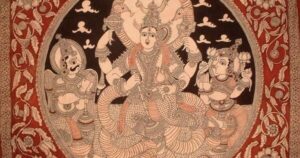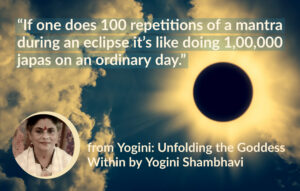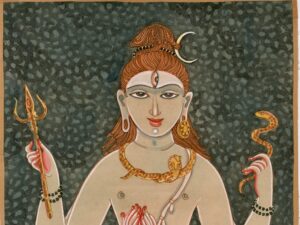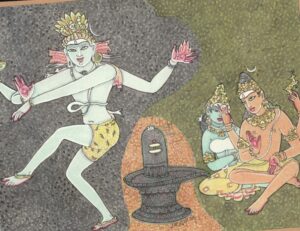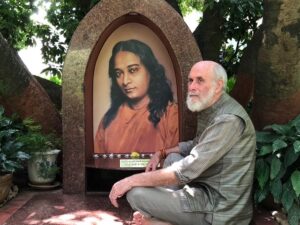By David Frawley (Pandit Vamadeva Shastri)
Vedic Yoga and the Spiritual Heart
The heart (hridaya) is the seat of the Self or Atman in Vedantic thought. Realization of the Self in the heart is the main Vedantic formulation of Moksha or liberation. The Upanishads laud the Self in the heart in many verses and make it the object of many vidyas(ways of knowledge). So do many other Vedantic texts up to modern times. When we refer to ourselves we point to the heart. Compared to the heart, the mind is just our computer system where we hold our information, not our real consciousness or self-identity.
Yet the heart is not just the seat of the Self; as such, it is also the source of all the main aspects and faculties of our entire nature as embodied souls. It is the seat of the mind (chitta) as the Yoga Sutras indicate. By this is meant not the outer mind but the inner, core or source mind, the source of all our karmas and samskaras. The heart is similarly the source of Prana or our life energy, the force that animates our various bodies from birth to birth, not merely as the breath but as the power behind all that we can do or think. The heart is also the ultimate source of speech and when we speak truly we speak from the heart.
The heart is the source of our entire being. All our different faculties are like different rays branching out from the central light of the heart which is like the Sun. All our energies are conduits of the energy of the heart, however far they may wander from it. In deep sleep we return to this inner light for peace and renewal, showing that we cannot remain apart from it even for a day.
Yet the heart is not just the source of our individual existence (Atman). It is also our place of unity and connection with the cosmic existence (Brahman). It spreads not just through our entire individual beingness but throughout the entire universe. In the heart resides our main connection with the Devatas, the great cosmic powers, the Gods and Goddesses which rule the universe, its evolution and its different planes of existence. Each one of our individual faculties arising from the heart has its corresponding cosmic Deva ruling a corresponding power of nature and the greater universe. The sun, the moon, the stars, the earth and all aspects of the cosmic creative force dwell within the heart.
This heart or hridaya is obviously not the mere physical organ. Nor is it simply the heart center, the anahata chakra of the subtle body, though it is closely related to it. This heart is the core of our being, which is the core of Being itself. The heart is where we experience our own self-being and through it contact the nature of all things. This hridaya could be better called the ‘spiritual heart’ in distinction to the physical and subtle heart centers.
The following is a beautiful prayer of consecration to heart from the Krishna Yajur Veda (Taittiriya Brahmana). It is still commonly chanted in ashrams and temples today, though not everyone contemplates its true meaning. It is often included in the greater Rudram chant sacred to Lord Shiva. It consists of a consecration of all of our faculties, along with their cosmic counterparts, into the heart and the Supreme Being within that. In this way, this heart prayer reconstructs the Cosmic Person (Purusha), the universal Self that is our true Being and is the Brahman, the being of the entire universe. Only when we place the cosmic powers into our individual faculties can we return them to our true heart that is universal.
Such a consecration in the heart is true Pratyahara in the Yogic sense, withdrawing all our faculties for the highest meditation. It is the reintegration of our scattered energy and attention into the Supreme Self, which is the supreme Yoga, the Yoga of the spiritual heart. It can be performed as preliminary to or along with Self-inquiry in order to make it more effective. It can be done along with any other Yoga practices as well. I have added a short commentary to make this ancient Vedic prayer more relevant to the modern reader who may not understand the underlying Vedic concepts.
1. May fire (Agni) be placed in my speech (Vak), my speech in the heart (hridaya), the heart in me (mayi), the I (aham) in the immortal (amritam), the immortal in Brahman.
By Agni or Fire is here meant the Divine light hidden in matter, the way fire is hidden in wood. Through this hidden light of the immanent Divine alone are we able to articulate ourselves, bringing the light of the Self into our activities through the power of speech.
2. May the Wind (Vayu) be placed in my breath (Prana), my breath in the heart, the heart in me, the I in the immortal, the immortal in Brahman.
By Vayu or Wind is meant the Divine energy that operates in the universe on all levels of matter, life and mind. Through this Divine cosmic energy alone all action occurs and our own Prana is able to function, giving us life and capacity on all levels.
3. May the Sun be placed in my eye, my eye in the heart, the heart in me, the I in the immortal, the immortal in Brahman.
By Surya or the Sun is meant the Divine light that illumines the world, which inwardly is the light of consciousness through which the eye functions and the mind perceives
4. May the Moon be placed in my mind, my mind in the heart, the heart in me, the I in the immortal, the immortal in Brahman.
By the Chandra or the Moon is meant the reflective power of the Divine light and awareness to feel and to understand, which is the basis of our emotional nature.
5. May the Directions be placed in my hearing, my hearing in the heart, the heart in me, the I in the immortal, the immortal in Brahman.
The directions of space reflect the Divine presence that envelopes and comprehends everything. Through these powers of space through we can hear, listen and know and become one with the cosmic space that is the space within us.
6. May the Waters placed in my generative fluid, my generative fluid in the heart, the heart in me, the I in the immortal, the immortal in Brahman.
The cosmic Waters are the creative powers in the universe, the Divine Mothers through which all creativity occurs down to the level of procreation. When we link our creative powers with those of the heart, we are reborn through the heart, into immortality, entering into the cosmic waters of consciousness.
7. May the Earth be placed in my body, my body in the heart, the heart in me, the I in the immortal, the immortal in Brahman.
The entire Earth is our real body, of which our physical body is but a representative. This essence of the body dwells in the heart. It is created out of the heart’s desire for embodied existence and lasts as long as this desire continues. By returning the desire for the body into the heart, we can experience the entire universe as our own greater body.
8. May herbs and trees be placed in my hair, my hair in the heart, the heart in me, the I in the immortal, the immortal in Brahman.
All of nature is part of our greater or cosmic body, as we are all the Purusha or Cosmic Person in various forms. By placing all aspects of nature in our heart, which is their true home, we can experience all of nature as ourselves.
9. May Indra be placed in my strength, my strength in the heart, the heart in me, the I in the immortal, the immortal in Brahman.
Indra is the Lord of Power or Shakti, who rules over the universe both externally and internally, as the master force behind all energies and actions. Our true strength, which is that of the heart, is only that of Indra. When we know this, we have the strength of Indra, we gain the universal power!
10. May the Rain God (Parjanya) be placed in my head, my head in the heart, the heart in me, the I in the immortal, the immortal in Brahman.
Parjanya here is the deity of the brain marrow, the subtle fluid or Soma that exists in the head. Placing this creative force of the sky in our heads, we can experience the rain of bliss.
11. May Shiva be placed in my spirit, my spirit in the heart, the heart in me, the I in the immortal, the immortal in Brahman.
Shiva here is Ishana, a Vedic form of Shiva, as the supreme power behind the universe. His spirit or manyu is his energetic spirit, his will-power that directs all things. Placing that Divine will in us, our natural motivation must take us to the Supreme.
12. May my self be placed in the Self, the Self in the heart, the heart in me, the I in the immortal, the immortal in Brahman.
All these consecrations are different forms of placing the Self into the Self, merging the powers of the universal Self into the individual Self, into the heart, into the I, into the immortal, and finally into Brahman, the Absolute. All life really consists of such offerings of the Self to the Self, Brahman to Brahman, God to God.
13. May my Self return again. May my life (Ayur) return again. May my Prana return again. May my will return again.
As long as we are caught in the ego-self, we don’t really have a Self. Our self is another, an object, an image, a worldly appearance or a bodily form. When we offer all aspects of our nature into the heart, we return to our true Self that is everyone and no one.
Similarly, as long as we are caught in the ego or worldly life, we don’t have a real life. We are ruled by Death, desire and compulsion. Only when we contact the universal life in the heart can we be said to be truly alive and to gain our true term of existence, which is immortal. Then all things and all creatures are our life! How much more wonderful this is than merely being trapped in a personal life that is of little interest to anyone but ourselves.
Through this mergence in the heart we gain the highest Prana, which is not just the power of the breath, but the universal vitality and energy. Then our true will, which is for the good of all, natrually returns. Our lives become an offering of joy to joy.
14. May the Universal God (Vaishvanara) increasing with his rays dwell within me as the guardian of immortality.
Agni Vaishvanara or the Universal God is the Vedic symbol for the Supreme Self and liberated soul according to great modern Rishis like Ganapati Muni and Kapali Shastri. All our individual faculties and all their corresponding cosmic powers are portions of his being, which also transcends them.
The Vedic sacrificial journey takes us from the lower form of Agni or fire, which is speech, to the highest form, Vaishvanara, the universal being, the Supreme Self identified with the Sun or the supreme light, Vishnu himself. A related teaching about Agni Vaishvanara occurs in the Chandogya Upanishad.
Notes:
Each of our individual faculties (those of the individual Self or Jivatman) has its cosmic counterpart or correlation with the Universal Being (those of the Supreme Self or Paramatman). Those listed here are the typical Vedic correspondences starting with our five main faculties of speech, breath, eye, mind and ear and their cosmic counterparts of Fire, Wind, Sun, Moon and the Directions of Space. These are the five main faculties of the subtle body or linga sharira. They represent not only the outer organs but their inner essences – our inner speech, inner breath, inner sight, inner mind and inner hearing. Our outer faculties are merely manifestations of these inner powers that are inherent in the soul or Jiva. These five are the five main factors of the internal Vedic sacrifice (Antaryaga) which is the Yoga offering. Ganapati Muni created new modern yogic sacrifice using Vedic verses relative to these five factors called Indra-Yajna.
When Bhagavan Ramana achieved his Self-realization as a mere lad of sixteen, he first simulated the death experience and merged all of his attention and vitality into the heart. This Vedic prayer provides a good method for doing this. It outlines the process of Self-inquiry, not only through the mind, but through all of our faculties. All of our energies have their root in the heart, even the core energy of the body itself. To really practice Self-inquiry is to practice it in such a complete, integral and holistic manner, not simply to repeat the question ‘Who am I’ mentally.
Yet it is not necessary to follow the details of this prayer in one’s meditation. What is important is to learn to merge our speech, breath, mind, eye, ear and other faculties into the heart, along with their cosmic counterparts. Whatever we trace to its origins takes us back to the heart, whether it is the thought-current, the breath-current, the current of speech, the current of attention through listening (the ears), or the place of focus of perception (through the eye). This return to the heart is the return to our true origin and to the Self. It is our real journey home to immortality where our True Being ever abides. This Hridaya-Vidya, expressed in this manner, can be used to combine and fulfill all other yogic approaches and all of our spiritual striving.

